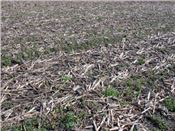Black Cutworm Moth Captures Common In Several Midwestern States
DR. MICHAEL GRAY
URBANA, ILL.
Impressive flights of black cutworm and armyworm moths have been reported by Doug Johnson an Extension Entomologist at the University of Kentucky. Entomologists at Purdue University also have received reports that black cutworm moth captures are now common in many areas of Indiana. Kelly Estes, Agricultural Pest Survey Coordinator with the Illinois Natural History Survey, has established a network of trapping cooperators across Illinois. Although no intense flights (nine or more moths caught over a 2-day period) of black cutworm moths have been reported by these cooperators, captures of this species have been common the past two weeks in the following counties: Champaign, Fayette, Logan, Lee, Macon, Macoupin, and Madison. This distribution of captures suggests that black cutworm moth flights have likely taken place throughout Illinois and growers are encouraged to remain vigilant for early signs of leaf feeding when corn seedlings begin to emerge. Strong winds from the south are undoubtedly bringing many black cutworm moths into Illinois and fields like the one featured in the photograph below will be prime targets for egg laying by this species.
For more complete information about the biology, life cycle, and management of black cutworms and armyworms, fact sheets are available from the Department of Crop Sciences, UIUC. Provided below is a brief overview of some key life cycle and management facts concerning black cutworms.
• Black cutworm moths are strong migratory insects with northward flights commonly observed from Gulf States into the Midwest from March through May.
• Moths are attracted to fields heavily infested with weeds such as chickweed, shepherd’s purse, peppergrass, and yellow rocket.
• Late tillage and planting tends to increase the susceptibility of fields to black cutworm infestations.
• Cutting of corn plants begins when larvae reach the 4th instar – with a single cutworm cutting an average of 3 to 4 plants during its larval development.
• Cutting tends to occur most often during nights or on dark overcast days.
• Fields at greatest risk to cutting and economic damage are in the 1-to-4 leaf stage of plant development.
• An early warning sign of potential economic damage includes small pinhole feeding injury in leaves (caused by the first 3 instars).
• A nominal threshold of 3 percent cutting of plants has traditionally been used as a point at which growers should consider a rescue treatment.
• Not all Bt hybrids offer adequate protection against black cutworm damage. Growers should consult the Handy Bt trait table prepared by Dr. Chris DiFonzo at Michigan State University to determine the level of protection provided by their chosen Bt hybrid.
As the season progresses, if you learn of significant black cutworm infestations, please let me know and I will share this information with the readers of this Bulletin. ∆
DR. MICHAEL GRAY: Extension Entomologist, University of Illinois

Champaign County field considered a prime target for black cutworm moth egg laying, April 21, 2015.